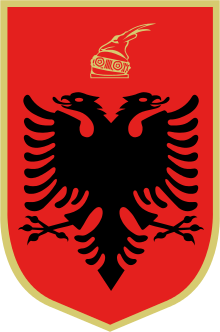Islamization of Albania
| Part of a series on |
| Albanians |
|---|
 |
| States |
| Communities |
| Subgroups |
| People |
The Islamization of Albania occurred as a result of the Ottoman conquest of Albania during the late 14th century. The Ottomans through their administration and military brought Islam to Albania through various polices and tax incentives, trade networks and transnational religious links. In the first few centuries of Ottoman rule, the spread of Islam in Albania was slow and mainly intensified during the seventeenth and eighteenth centuries due in part to greater Ottoman societal and military integration, geo-political factors and collapse of church structures. It was one of the most significant developments in Albanian history as Albanians in Albania went from being a nominally Christian (Catholic and Orthodox) population to one that is still mainly Muslim (Sunni and Bektashi). Apart from religious changes, conversion to Islam also brought about other social and cultural transformations that have shaped and influenced Albanians and Albanian culture.
History
Islam is believed to have first arrived in the 9th century to the region called Albania today.[1]
Early Ottoman period
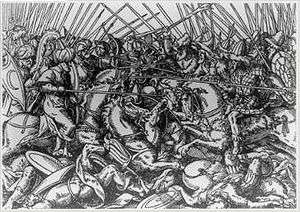
Albanians began converting to Islam when they became part of the Ottoman Empire in the late 14th century.[2] The uptake of Islam at first occurred mainly amongst the Christian elite who retained some previous political and economic privileges and the emerging class of timar or estate holders of the sipahis in the new Ottoman system.[3] These included aristocratic figures such as George Kastrioti (Skanderbeg) who while in the service of the Ottomans was a convert to Islam and later reverted to Christianity during the late 15th century northern Albanian uprising he initiated.[2] In doing so, he also ordered others who had embraced Islam or were Muslim colonists to convert to Christianity or face death.[2] During the conflicts between Skanderbeg and Ottomans the various battles and raiding pushed Sultan Mehmet II to construct the fortress of Elbasan (1466) in the lowlands to counter resistance coming from the mountain strongholds.[4] Prior to and after Skanderbeg's death (1468) parts of the Albanian aristocracy migrated to southern Italy with some number of Albanians to escape the Ottoman conquest whose descendants still reside in many villages they settled.[5] In the early period of Ottoman rule the areas that form contemporary Albania were reorganised into an administrative unit named Sancak-i Arnavid or Sancak-i Arnavud.[6] Whereas during the onset of Ottoman rule only prominent churches with significant symbolic meaning or cultural value of an urban settlement where converted into mosques.[7] Most early mosques constructed in Albania were mainly built within fortresses for Ottoman garrisons at times by Ottoman Sultans during their military campaigns in the area like Fatih Sultan Mehmet Mosque in Shkodër, the Red Mosque in Berat and others.[8][9]
-
Ruined Red Mosque within citadel, Berat.
-
Ruined mosque within citadel, Krujë.
-

Ruined Fatih Sultan Mehmet Mosque within Rozafa fortress, Shkodër.
Northern Albania
The Ottoman conquest of certain northern cities from the Venetians happened separately to the initial conquest of Albania from local feudal lords. Cities such as Lezhë fell in 1478, Shkodër during 1478–79 and Durrës in 1501 with the bulk of their Christian population fleeing.[10] Over the course of the sixteenth century the urban populations of these cites became primarily Muslim.[10] In the north, the spread of Islam was slower due to resistance from the Roman Catholic Church and the mountainous terrain which contributed to curb Muslim influence in the 16th century.[11] The Ottoman conquest and territorial reorganisation of Albania though affected the Catholic church as ecclesiastical structures were decimated.[12] The Ottoman wars with Catholic powers of Venice and Austria in the seventeenth century resulted in severe reprisals against Catholic Albanians who had rebelled which accentuated conversion to Islam.[13][14][15] Steep decreases therefore occurred during the 1630s-1670s where for example the number of Catholics in the diocese of Lezhë declined by 50%, whereas in the diocese of Pult Catholics went from being 20,000 to 4,045.[13] In 1703 pope Clement XI, himself of Albanian heritage, ordered a synod of local Catholic bishops that discussed stemming conversions to Islam which also agreed to deny communion to crypto-Catholics in Albania who outwardly professed Islam.[14][16]
Central Albania
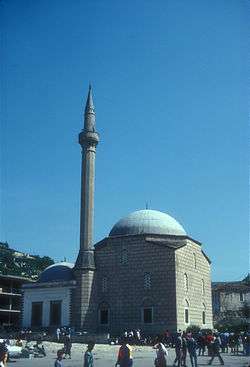
The official Ottoman recognition of the Orthodox church resulted in the Orthodox population being tolerated until the late 18th century and the traditionalism of the church's institutions slowed the process of conversion to Islam amongst Albanians.[15][17][18] The Orthodox population of central and south-eastern Albania was under the ecclesiastical jurisdiction of the Orthodox Archbishopric of Ohrid, while south-western Albania was under the Patriarchate of Constantinople through the Metropolis of Ioannina.[19][20] In the early 16th century the Albanian cites of Gjirokastër, Kaninë, Delvinë, Vlorë, Korçë, Këlcyrë, Përmet and Berat were still Christian and by the late 16th century Vlorë, Përmet and Himarë were still Christian, while Gjirokastër increasingly became Muslim.[19][21] Conversion to Islam in cities overall within Albania was slow during the 16th century as around only 38% of the urban population had become Muslim.[21][22] The city of Berat from 1670 onward became mainly Muslim and its conversion is attributed in part to a lack of Christian priests being able to provide religious services.[23] Differences between Christian Albanians of central Albania and archbishops of Ohrid led to conversions to Bektashi Islam that made an appeal to all while insisting little on ritual observance.[24] Central Albania, such as the Durrës area had by end of the 16th century become mainly Muslim.[21] Consisting of plains and being an in between area of northern and southern Albania, central Albania was a hub on the old Via Egnatia road that linked commercial, cultural and transport connections which were subject to direct Ottoman administrative control and religious Muslim influence.[25][26] The conversion to Islam of most of central Albania has thus been attributed in large part to the role its geography played in the socio-political and economic fortunes of the region.[25][26]
Southern Albania
It was mainly during the late eighteenth century however that Orthodox Albanians converted in large numbers to Islam due overwhelmingly to the Russo-Turkish wars of the period and events like the Russian instigated Orlov revolt (1770) that made the Ottomans view the Orthodox population as allies of Russia.[17][23][27][28] As some Orthodox Albanians rebelled against the Ottoman Empire, the Porte responded with and at times applied force to convert Orthodox Albanians to Islam while also providing economic measures to stimulate religious conversion.[17][23][28][29] During this time conflict between newly converted Muslim Albanians and Orthodox Albanians occurred in certain areas. Examples include the coastal villages of Borsh attacking Piqeras in 1744, making some flee abroad to places such as southern Italy.[30][31] While in other areas like in 36 villages north of the Pogoni area converted in 1760 which whereby the newly converted population followed it up with an attack on Orthodox villages of the Kolonjë, Leskovik and Përmet areas leaving many settlements sacked and ruined.[31] By the late eighteenth century socio-political and economic crises alongside nominal Ottoman government control resulted in local banditry and Muslim Albanian bands raided Greek, Vlach and Orthodox Albanian settlements located today within and outside contemporary Albania.[32][33][34][35] Within Albania those raids culminated in Vithkuq, mainly an Orthodox Albanian centre, Moscopole (Albanian: Voskopojë, Greek: Moschopolis) mainly a Vlach centre, both with Greek literary, educational and religious culture and other smaller settlements being destroyed that pushed some Vlachs and Orthodox Albanians to migrate afar to places such as Macedonia, Thrace and so on.[17][29][33][34][35][36] Some Orthodox individuals, known as neo-martyrs attempted to stem the tide of conversion to Islam amongst the Orthodox Albanian population and were executed in the process.[37] Notable among these individuals was Cosmas of Aetolia, (died 1779) a Greek monk and missionary who traveled and preached afar as Krujë, opened many Greek schools before being accused as a Russian agent and executed by Ottoman Muslim Albanian authorities.[38] Cosmas advocated for Greek education and spread of Greek language among illiterate Christian non-Greek speaking peoples so that they could understand the scriptures, liturgy and thereby remain Orthodox while his spiritual message is revered among contemporary Orthodox Albanians.[38][39][40] By 1798 a massacre perpetrated against the coastal Orthodox Albanian villages of Shënvasil and Nivicë-Bubar by Ali Pasha, semi-independent ruler of the Pashalik of Yanina led to another sizable wave of conversions of Orthodox Albanians to Islam.[17][27]
Other factors for conversion
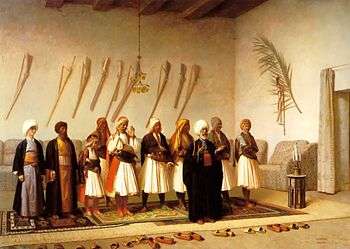
Other conversions such as those in the region of Labëria occurred due to ecclesiastical matters when for example during a famine the local bishop refused to grant a break in the fast to consume milk with threats of hell.[41] Conversion to Islam also was undertaken for economic reasons which offered a way out of heavy taxation such as the jizya or poll tax and other difficult Ottoman measures imposed on Christians while opening up opportunities such as wealth accumulation and so on.[15][41][42] Other multiple factors that led to conversions to Islam were the poverty of the Church, illiterate clergy, a lack of clergy in some areas and worship in a language other than Albanian.[15][23][26][41] Additionally the reliance of the bishoprics of Durrës and southern Albania upon the declining Archbishopric of Ohrid, due in part to simony weakened the ability of Orthodox Albanians in resisting conversion to Islam.[23][26] Crypto-Christianity also occurred in certain instances throughout Albania in regions such as Shpat amongst populations that had recently converted from Christian Catholicism and Orthodoxy to Islam.[13][14][15][37][43] While Gorë, a borderland region straddling contemporary north-eastern Albania and southern Kosovo, its Slavic Orthodox population converted to Islam during the latter half of the eighteenth century due to the abolition of the Serbian Patriarchate of Peć (1766) and subsequent unstable ecclesiastical structures.[44] Whereas starting from the seventeenth and increasing in the following centuries, the mainly Slavic Orthodox population of the now Albanian borderland central-eastern region of Gollobordë converted to Islam.[45] The Romani people entered Albania sometime in the fifteenth century and those that were Muslim became part of local Muslim Ottoman society.[46][47]
Muslim Albanians and the wider Ottoman world
In the center and south by the end of the seventeenth century the urban centers had largely adopted the religion of the growing Muslim Albanian elite. The existence of an Albanian Muslim class of pashas and beys, having military employment as soldiers and mercenaries while also able to join the Muslim clergy played an increasingly important role in Ottoman political and economic life that became an attractive career option for many Albanians.[8][48][49][50] Depending on their role, these people in Muslim Albanian society attained a respectable position as they preformed administrative tasks and maintained security in urban areas and sometimes were rewarded by the Ottoman state with high ranks and positions.[8] As such, Albanians were also represented in sizable numbers at the imperial Ottoman court.[51] Alongside Christians though, many Muslim Albanians were poor and partially serfs that worked on the land of the emerging landowning Ottoman Albanian elite while others found employment in business, as artisans and in other jobs.[15] Sunni Islam was promoted and protected by Ottoman governors and feudal society that resulted in support and spread of dervish Sufi orders considered more orthodox in the Balkans region.[52] Foremost of these were the Bektashi order who were considered Sunni by means of association with shared legal traditions, though viewed as Shiite by everyday Muslims due to esoteric practices such as revering Ali, Hassan, Husein and other notable Muslim figures.[53][54] During Ottoman rule the Albanian population partially and gradually began to convert to Islam through the teachings of Bektashism in part to gain advantages in the Ottoman trade networks, bureaucracy and army.[55] Many Albanians were recruited into the Ottoman Janissary and Devşirme and 42 Grand Viziers of the Ottoman Empire were of Albanian origin. The most prominent Albanians during Ottoman rule were Koca Davud Pasha, Hamza Kastrioti, Iljaz Hoxha, Köprülü Mehmed Pasha, Ali Pasha, Edhem Pasha, Ibrahim Pasha of Berat, Köprülü Fazıl Ahmed, Muhammad Ali of Egypt, Kara Mahmud Bushati and Ahmet Kurt Pasha.
-

Muradie Mosque in Vlorë.
-
Naziresha Mosque in Elbasan.
-
Bazaar Mosque in Krujë.
-

Clock Mosque in Peqin.
-
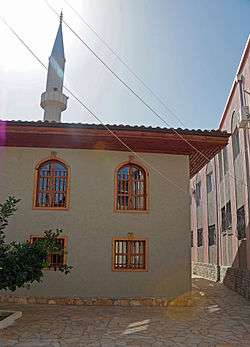
Fatih Mosque in Durrës.
-
King Mosque in Berat.
Muslim denominations and sects
Besides those associated with Sunni Islam, the Muslims of Albania during the Ottoman period belonged to several Sufi Orders.[56] The Qadiri order spread within urban areas of the seventeenth century and was linked with guilds of urban workers while in the 18th century the Qadiri had spread into central Albania and in particular the mountainous Dibër region.[56] The Qadiri contributed to the economic, and in the Dibër area, the socio-political milieu where they were based.[56] The Halveti order who competed with the Bektashis for adherents and based in the south and northeast of Albania.[56] Other Sufi orders were the Rufai and the Melami and so on. The most prominent of these in Albania were and still are the Bektashis, a mystic Dervish order belonging to Shia Islam that came to Albania during the Ottoman period, brought first by the Janissaries in the 15th century.[23] The spread of Bektashism amongst the Albanian population though occurred during the 18th and mainly early 19th centuries, especially in the domains of Ali Pasha who is thought to have been a Bektashi himself.[23][48][57][58] Sufi dervishes from places afar like Khorasan and Anatolia arrived, proselytized, gained disciples and in time a network of tekkes was established that became centres of Sufism in regions such as Skrapar and Devoll.[48] Some of the most prominent tekkes in Albania were in settlements such as Gjirokastër, Melçan, Krujë and Frashër.[48] Of the Bektashi order by the early 20th century Albanians formed a sizable amount of its dervishes outside the Balkans, even at the tekke of Sufi saint Haji Bektash in Anatolia and in Egypt.[59][60] Sufi orders, in particular the Bektashis associate Christian saints and their local shrines with Sufi holy men creating a synthesis and syncretism of religious observance and presence.[48][50][61] For Albanian converts to Islam, Bektashism with its greater religious freedoms and syncretism was viewed at times as a more appealing option to adhere to.[23][50][61] The Bektashi sect is considered heretical by conservative Muslims.[37] Traditionally Bektashis are found in sizable numbers within southern Albania and to a lesser extent in central Albania, while the rest of the Muslim population belong to Sunni Islam.[23][62]
-

Teqe in Berat of the Sufi Halveti order (built 1782).
-
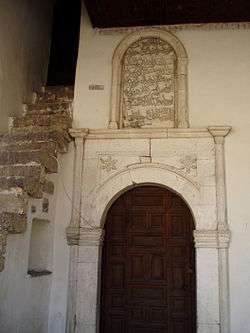
Arabic script inscription above door at Halveti teqe, Berat.
-

Melani teqe of the Bektashi in Gjirokastër.
-
Dollma Teqe in Krujë.
-

Interior of Dollma teqe with Sufi saints tombs in background, Krujë.
Social and cultural change
"Despite the current lack of open religious fervor among the Albanians, Islam has contributed substantially to making the Albanians what they are today. It is now an inherent feature of Albania's national culture and to be treated and respected as such."
Robert Elsie (albanologist), 2001.[63]
The Ottoman conquest also brought social, cultural and linguistic changes into the Albanian-speaking world. From the fifteenth century onward words from Ottoman Turkish entered the Albanian language.[64] While a corpus of poets and other Muslim Albanian authors wrote in Ottoman Turkish, Arabic, Persian or in the Albanian language in Arabic script (aljamiado) encompassing narrative prose, poetry, reflective works on religion and socio-political situations and so on.[64][65] Prominent amongst these authors were Yahya bey Dukagjini, Haxhi Shehreti or bejtexhinj poets like Nezim Frakulla, Muhamet Kyçyku, Sulejman Naibi, Hasan Zyko Kamberi, Haxhi Ymer Kashari and others.[64] Towns and cities in Albania underwent change as they adopted Ottoman architectural and cultural elements.[9] Apart from Elbasan founded (1466) around a fortress, other settlements with the construction of buildings related to religion, education and social purposes like mosques, madrassas, imarets and so on by the Ottoman Muslim Albanian elite became new urban centres like Korçë, Tiranë and Kavajë.[66] Older urban centres for example Berat attained mosques, hamams (Ottoman bathhouses), madrasas (Muslim religious schools), coffee houses, tekes and became known for its poets, artists and scholarly pursuits.[64] Unlike Kosovo or Macedonia, architecturally Albania's Ottoman Muslim heritage was more modest in number, though prominent structures are the Mirahori Mosque in Korçë (built 1495–96), Murad Bey Mosque in Krujë (1533–34), Lead Mosque in Shkodër (1773–74), Et'hem Bey Mosque in Tiranë (begun 1791–94; finished 1820–21) and others.[67] Conversion from Christianity to Islam for Albanians also marked a transition from Rum (Christian) to Muslim confessional communities within the Ottoman millet system that collectively divided and governed peoples according to their religion.[32] The Ottomans were nonetheless aware of the existence of Muslim Albanians and used terms like Arnavud (اروانيد) extensively as an ethnic marker to address the shortcomings of the usual millet religious terminology to identify people in Ottoman state records.[32][68] While the country was referred to as Arnavudluk (آرناوودلق).[68] Also a new and generalised response by Albanians based on ethnic and linguistic consciousness to this new and different Ottoman world emerging around them was a change in ethnonym.[69] The ethnic demonym Shqiptarë, derived from Latin connoting clear speech and verbal understanding gradually replaced Arbëresh/Arbënesh amongst Albanian speakers between the late 17th and early 18th centuries.[69]
Legacy
Within scholarship in contemporary times, the conversion of Albanians and the legacy of Islam within Albania is a contested topic. According to scholar Hasan Kaleshi, the Ottoman conquest and conversion to Islam by Albanians averted assimilation into Slavs the same way that the Slavic invasions of the 6th century halted the romanization process of the progenitors of the Albanians.[70] Kaleshi maintained that though recognised within the millet system as Muslims only, Albanians were able to survive and even to geographically expand their Balkan area of settlement under the Ottomans.[70] Contemporary Albanian scholars, some with nationalist leanings interpret the Ottoman period as negative and downplay the conversion to Islam as having had barely any benefits to Albanians in a socio-cultural and religious sense.[70][71]
See also
- Muslim Community of Albania
- Bektashi Order
- Bektashism and folk religion
- History of Ottoman Albania
- Religion in Albania
- Christianity in Albania
References
Citations
- ↑ Jazexhi 2013, pp. 21–24.
- 1 2 3 Ramet 1998, p. 209. "The Ottomans first invaded Albania in 1385. A second Ottoman force was sent to Albania 1394-96, occupying the country. Given both the Ottoman disposition to tolerate religious diversity among loyal subjects and the generally bellicose traditions of the Albanians, Ottoman authorities adopted a conciliatory policy toward Albanian Christians in the early decades of occupation. Still, although conversion to Islam was not required, a Christian Albanian lord could count on winning favor if he converted. If the Ottomans did not believe that religious reasons could compel a Christian to convert to Islam, they nonetheless looked askance when a Muslim converted (or reconverted) to Christianity. This happened in 1443 when Gjergj Kastrioti (called Skenderbeg), who had been reared as a Muslim in the sultan's palace, abandoned the Islamic faith and publicly reverted to the creed of his forefathers. But this conversion was not merely a public gesture of defiance. It was the first act in a revolutionary drama. For, after changing his religious allegiance, Skenderbeg demanded that Muslim colonists and converts alike embrace Christianity on pain of death, declaring a kind of holy war against the sultan/caliph."
- ↑ Ergo 2010, p. 22.
- ↑ Inalcik 1989, p. 327.
- ↑ Nasse 1964, pp. 24–26
- ↑ Norris 1993, pp. 36–37.
- ↑ Ergo 2010, p. 18.
- 1 2 3 Nurja 2012, pp. 197–198.
- 1 2 Ergo 2010, pp. 34–35.
- 1 2 Malcolm 2015, pp. 12–13.
- ↑ Ramet 1998, pp. 209–210.
- ↑ Ergo 2010, p. 8.
- 1 2 3 Ramet 1998, p. 210. "Then, in 1644, war broke out between Venice and the Ottoman empire. At the urging of the clergy, many Albanian Catholics sided with Venice. The Ottomans responded with severe repressions, which in turn drove many Catholics to embrace Islam (although a few elected to join the Orthodox Church instead)... Within the span of twenty-two years (1649-71) the number of Catholics in the diocese of Alessio fell by more than 50 percent, while in the diocese of Pulati (1634-71) the number of Catholics declined from more than 20,000 to just 4,045. In general, Albanian insurrections during the Ottoman-Venetian wars of 1644-69 resulted in stiff Ottoman reprisals against Catholics in northern Albania and significantly accelerated Islamization… In general, a pattern emerged. When the Ottoman empire was attacked by Catholic powers, local Catholics were pressured to convert, and when the attack on the Ottoman empire came from Orthodox Russia, the pressure was on local Orthodox to change faith. In some cases Islamization was only superficial, however, and in the nineteenth century many villages and some entire districts remained "crypto-Catholic" in spite of the adopting the externals of Islamic culture."
- 1 2 3 Skendi 1967b, pp. 235–242.
- 1 2 3 4 5 6 Lederer 1994, pp. 333–334.
- ↑ Frazee 2006, pp. 167–168.
- 1 2 3 4 5 Ramet 1998, p. 203. "The Ottoman conquest between the end of the fourteenth century and the mid-fifteenth century introduced a third religion – Islam - but the Turks did not at first use force in its expansion, and it was only in the 1600s that large-scale conversion to Islam began – chiefly, at first, among Albanian Catholics."; p.204. "The Orthodox community enjoyed broad toleration at the hands of the Sublime Porte until the late eighteenth century."; p. 204. "In the late eighteenth century Russian agents began stirring up the Orthodox subjects of the Ottoman empire against the Sublime Porte. In the Russo-Turkish wars of 1768-74 and 1787-91 Orthodox Albanians rose against the Turks. In the course of the second revolt the "New Academy" in Voskopoje was destroyed (1789), and at the end of the second Russo-Turkish war more than a thousand Orthodox fled to Russia on Russian warships. As a result of these revolts, the Porte now applied force to Islamicize the Albanian Orthodox population, adding economic incentives to provide positive stimulus. In 1798 Ali Pasha of Janina led Ottoman forces against Christian believers assembled in their churches to celebrate Easter in the villages of Shen Vasil and Nivica e Bubarit. The bloodbath unleashed against these believers frightened Albanian Christians in other districts and inspired a new wave of mass conversions to Islam."
- ↑ Ergo 2010, p. 26.
- 1 2 Ergo 2010, p. 37.
- ↑ Giakoumis 2010, pp. 79–81.
- 1 2 3 Giakoumis 2010, p. 84.
- ↑ Ergo 2010, p. 38.
- 1 2 3 4 5 6 7 8 9 Skendi 1967a, pp. 10–13.
- ↑ Winnifrith 2002, p. 107."But the difficult archbishops of Ohrid must have produced some difference in their flocks. Less contentious faiths were available. It so happens that converting to Islam in central Albania was eased by the strength there of the Bektashi cult, a mystical faith, designed to appeal to all, demanding little in the way of strict rules of observance."
- 1 2 Pistrick 2013, p. 78.
- 1 2 3 4 Skendi 1956, pp. 316, 318–320.
- 1 2 Skendi 1956, pp. 321–323.
- 1 2 Vickers 2011, p. 16.
- 1 2 Koti 2010, pp. 16–17.
- ↑ Kallivretakis 2003, p. 233.
- 1 2 Hammond 1967, p. 30.
- 1 2 3 Anscombe 2006, p. 88. "This Albanian participation in brigandage is easier to track than for many other social groups in Ottoman lands, because Albanian (Arnavud) was one of the relatively few ethnic markers regularly added to the usual religious (Muslim-Zimmi) tags used to identify people in state records. These records show that the magnitude of banditry involving Albanians grew through the 1770s and 1780s to reach crisis proportions in the 1790s and 1800s."; p.107. "In light of the recent violent troubles in Kosovo and Macedonia and the strong emotions tied to them, readers are urged most emphatically not to draw either of two unwarranted conclusions from this article: that Albanians are somehow inherently inclined to banditry, or that the extent of Ottoman "Albania" or Arnavudluk (which included parts of present-day northern Greece, western Macedonia, southern Montenegro, Kosovo, and southern Serbia) gives any historical "justification" for the creation of a "Greater Albania" today."
- 1 2 Hammond 1976, p. 62.
- 1 2 Koukoudis 2003, pp. 321–322. "Particularly interesting is the case of Vithkuq, south of Moschopolis, which seems to have shared closely in the town's evolution, though it is far from clear whether it was inhabited by Vlachs in the glory days before 1769. It may well have had Vlach inhabitants before 1769, though the Arvanites were certainly far more numerous, if not the largest population group. This is further supported by the linguistic identity of the refugees who fled Vithkuq and accompanied the waves of departing Vlachs. Today it is inhabited by Arvanites and Vlachs, though the forebears of the modern Vlach residents arrived after the village had been abandoned by its previous inhabitants and are mainly of Arvanitovlach descent. They are former pastoral nomads who settled permanently in Vithkuq."; p. 339. "As the same time as, or possibly shortly before or after, these events in Moschopolis, unruly Arnauts also attacked the smaller Vlach and Arvanitic communities round about. The Vlach inhabitants of Llengë, Niçë, Grabovë, Shipckë, and the Vlach villages on Grammos, such as Nikolicë, Linotopi, and Grammousta, and the inhabitants of Vithkuq and even the last Albanian speaking Christian villages on Opar found themselves at the mercy of the predatory Arnauts, whom no-one could withstand. For them too, the only solution was to flee... During this period, Vlach and Arvanite families from the surrounding ruined market towns and villages settled alongside the few Moscopolitans who had returned. Refugee families came from Dushar and other villages in Opar, from Vithkuq, Grabovë, Nikolicë, Niçë, and Llengë and from Kolonjë."
- 1 2 Jorgaqi 2005, pp. 38–39.
- ↑ Winnifrith 2002, p. 109. "Of these Vithkuq... All these villages have a Vlach element in their population, and it is Vlach tradition that they were large and important... This culture was of course Greek culture...
- 1 2 3 Giakoumis 2010, pp. 89–91.
- 1 2 Elsie 2001, pp. 59–60.
- ↑ Elsie 2000, p. 48.
- ↑ Mackridge 2009, pp. 58–59.
- 1 2 3 Giakoumis 2010, pp. 86–87.
- ↑ Norris 1993, pp. 47–48.
- ↑ Pistrick 2013, pp. 79–81.
- ↑ Duijzings 2000, p. 16.
- ↑ Limanoski 1989, p. 74.
- ↑ De Soto, Beddies & Gedeshi 2005, p. 7.
- ↑ Crowe 1996, p. 196.
- 1 2 3 4 5 Norris 1993, pp. 123–137, 155–160.
- ↑ Hammond 1967, p. 217.
- 1 2 3 Babuna 2004, pp. 290–291.
- ↑ Ergo 2010, p. 23.
- ↑ Norris 1993, p. 101.
- ↑ Blumi & Krasniqi 2014, pp. 480–482.
- ↑ Doja 2006, pp. 91–93; 100–102.
- ↑ Doja 2006, pp. 86–87.
- 1 2 3 4 Clayer 2007, pp. 33–36.
- ↑ Doja 2006, pp. 94–98.
- ↑ Gawrych 2006, pp. 21–22.
- ↑ Norris 1993, pp. 212–218.
- ↑ Hasluck 1913, p. 97.
- 1 2 Hasluck 1913, pp. 106–119.
- ↑ Jazexhi 2014, pp. 22–23.
- ↑ Elsie 2001, p. 126.
- 1 2 3 4 Norris 1993, pp. 61–81.
- ↑ Elsie 1992, pp. 289–305.
- ↑ Nurja 2012, p. 193.
- ↑ Norris 1993, p. 56.
- 1 2 Anscombe 2006b, p. 772. "In this case, however, Ottoman records contain useful information about the ethnicities of the leading actors in the story. In comparison with ‘Serbs’, who were not a meaningful category to the Ottoman state, its records refer to ‘Albanians’ more frequently than to many other cultural or linguistic groups. The term ‘Arnavud’ was used to denote persons who spoke one of the dialects of Albanian, came from mountainous country in the western Balkans (referred to as ‘Arnavudluk’, and including not only the area now forming the state of Albania but also neighbouring parts of Greece, Macedonia, Kosovo, and Montenegro), organized society on the strength of blood ties (family, clan, tribe), engaged predominantly in a mix of settled agriculture and livestock herding, and were notable fighters — a group, in short, difficult to control. Other peoples, such as Georgians, Ahkhaz, Circassians, Tatars, Kurds, and Bedouin Arabs who were frequently identified by their ethnicity, shared similar cultural traits."
- 1 2 Lloshi 1999, p. 277. "They called themselves arbënesh, arbëresh, the country Arbëni, Arbëri, and the language arbëneshe, arbëreshe. In the foreign languages, the Middle Ages denominations of these names survived, but for the Albanians they were substituted by shqiptarë, Shqipëri and shqipe. The primary root is the adverb shqip, meaning "clearly, intelligibly". There is a very close semantic parallel to this in the German noun Deutsche, "the Germans" and "the German language" (Lloshi 1984) Shqip spread out from the north to the south, and Shqipni/Shqipëri is probably a collective noun, following the common pattern of Arbëni, Arbëri. The change happened after the Ottoman conquest because of the conflict in the whole line of the political, social, economic, religious, and cultural spheres with a totally alien world of the Oriental type. A new and more generalised ethnic and linguistic consciousness of all these people responded to this."
- 1 2 3 Elsie 2005, p. 34. "Modern Albanian scholars tend to view the consequences of these centuries of Turkish rule as completely negative, in terms of wild Asiatic hordes ravaging and plundering a country which might otherwise have flourished in the cradle of European civilization... Scholar Hasan Kaleshi (1922–1976) has convincingly suggested that the Turkish occupation of the Balkans had at least the one positive consequence. It saved the Albanians from ethnic assimilation by the Slavs, just as the Slavic invasion of the Balkans in the sixth century had put an end to the process of Romanization which had threatened to assimilate the non-Latin-speaking ancestors of the Albanians a thousand years earlier. Although not recognized by the Turks as an ethnic minority (the population of the Ottoman Empire was divided according to religion, not according to nationality), the Albanians managed to survive as a people and indeed substantially expand their areas of settlement under Turkish rule."
- ↑ Kopanski 1997, p. 192. "The sophisticated culture, literature and art of Islam were ignored by the generality of historians who hardly even tried to conceal their anti-Muslim bias. Their ferociously anti-Islamic and anti-Turkish attitude not only obscured and distorted the amazing process of mass conversion of entire Christian communities to Islam, but also provided an intellectual prop for the ultra nationalist policy of ethnic and religious cleansing in Bosnia, Hum (Herzegovina), Albania, Bulgaria and Greece. For against the backdrop of the history of the Balkans, as generally portrayed, what appeared as a kind of historical exoneration and an act of retaliation for the 'betrayal' of Christianity in the Middle Ages. The policy of destroying Islamic culture and way of life in Albania after the World War II is the primary reason why the history of medieval Islam in this land has not been properly studied. And when it was studied, it was studied within the parameters of the Stalinist ideology which emphasized only the mythical image of medieval Albanians as the 'heroic Illyrian proletariat'. The handful of Muslim scholars in the Communist Eastern Europe who resisted the anti-Islamic and anti-Turkish propaganda were ostracized and often penalized. Albanian nationalist historians like Ramadan Marmallaku, Kristo Frashëri Skender Anamali, Stefanaq Pollo, Skender Rizaj and Arben Puto in their books deliberately emphasized ad nauseam only 'the Turkish savagery' and the 'heroic' Christian resistance against the Osmanli state in Albania."
Sources
- Anscombe, Frederick (2006). "Albanians and "mountain bandits"". In Anscombe, Frederick. The Ottoman Balkans, 1750–1830. Princeton: Markus Wiener Publishers. pp. 87–113. ISBN 9781558763838.
- Anscombe, Frederick (2006b). "The Ottoman Empire in Recent International Politics - II: The Case of Kosovo". The International History Review. 28 (4): 758–793.
- Babuna, Aydin (2004). "The Bosnian Muslims and Albanians: Islam and Nationalism". Nationalities Papers. 32 (2): 287–321.
- Blumi, Isa; Krasniqi, Gëzim (2014). "Albanians' Islam". In Cesari, Jocelyne. The Oxford Handbook of European Islam. Oxford: Oxford University Press. pp. 475–516. ISBN 9780191026409.
- Clayer, Nathalie (2007). "Saints and Sufi's in post-Communist Albania". In Kisaichi, Masatoshi. Popular Movements and Democratization in the Islamic World. London: Routledge. pp. 33–42. ISBN 9781134150618.
- Crowe, David (1996). A history of the Gypsies of Eastern Europe and Russia. New York: St Martin's Griffin. ISBN 9781349606719.
- De Soto, Hermine; Beddies, Sabine; Gedeshi, Ilir (2005). Roma and Egyptians in Albania: From social exclusion to social inclusion. Washington D.C: World Bank Publications. ISBN 9780821361719.
- Doja, Albert (2006). "A Political History of Bektashism in Albania". Totalitarian Movements and Political Religions. 7 (1): 83–107.
- Gawrych, George (2006). The crescent and the eagle: Ottoman rule, Islam and the Albanians, 1874–1913. London: IB Tauris. ISBN 9781845112875.
- Duijzings, Gerlachlus (2000). Religion and the politics of identity in Kosovo. London: Hurst & Company. ISBN 9781850654315.
- Elsie, Robert (1992). "Albanian Literature in the Moslem Tradition: Eighteenth and Early Nineteenth Century Albanian Writing in Arabic Script". Oriens. 33: 287–306.
- Elsie, Robert (2000). "The Christian Saints of Albania". Balkanistica. 13 (36): 35–57.
- Elsie, Robert (2001). A dictionary of Albanian religion, mythology, and folk culture. London: Hurst & Company. ISBN 9781850655701.
- Elsie, Robert (2005). Albanian literature: A short history. London: I.B. Tauris. ISBN 9781845110314.
- Ergo, Dritan (2010). "Islam in the Albanian lands (XVth-XVIIth Century)". In Schmitt, Oliver Jens. Religion und Kultur im albanischsprachigen Südosteuropa [Religion and culture in Albanian-speaking southeastern Europe]. Frankfurt am Main: Peter Lang. pp. 13–52. ISBN 9783631602959.
- Frazee, Charles (2006). Catholics and Sultans: The Church and the Ottoman Empire 1453–1923. Cambridge: Cambridge University Press. ISBN 9780521027007.
- Hammond, Nicholas Geoffrey Lemprière (1967). Epirus: the Geography, the Ancient Remains, the History and Topography of Epirus and Adjacent Areas. Oxford: Clarendon Press. ISBN 9780198142539.
- Hammond, Nicholas Geoffrey Lemprière (1976). Migrations and invasions in Greece and adjacent areas. Park Ridge: Noyes Press. ISBN 9780815550471.
- Giakoumis, Konstantinos (2010). "The Orthodox Church in Albania Under the Ottoman Rule 15th-19th Century". In Schmitt, Oliver Jens. Religion und Kultur im albanischsprachigen Südosteuropa [Religion and culture in Albanian-speaking southeastern Europe] (PDF). Frankfurt am Main: Peter Lang. pp. 69–110. ISBN 9783631602959.
- Inalcik, Halil (1989). "The Ottoman Turks and the Crusades, 1451–1522". In Hazard, Harry; Zacour, Norman. A History of the Crusades: The Impact of the Crusades on Europe. University of Wisconsin Press. pp. 222–275. ISBN 9780299107444.
- Hasluck, Frederick (1913). "Ambiguous Sanctuaries and Bektashi Propaganda". The Annual of the British School at Athens. 20: 94–119.
- Jazexhi, Olsi (2013). "Albania". In Nielsen, Jørgen; Akgönül, Samim; Alibašić, Ahmet; Racius, Egdunas. Yearbook of Muslims in Europe: Volume 5. Leiden: Brill. pp. 21–36. ISBN 9789004255869.
- Jazexhi, Olsi (2014). "Albania". In Nielsen, Jørgen; Akgönül, Samim; Alibašić, Ahmet; Racius, Egdunas. Yearbook of Muslims in Europe: Volume 6. Leiden: Brill. pp. 19–34. ISBN 9789004283053.
- Jorgaqi, Nasho (2005). Jeta e Fan S. Nolit: Vëllimi 1. 1882–1924 [The life of Fan S. Noli: Volume 1. 1882–1924]. Tiranë: Ombra GVG. ISBN 9789994384303.
- Kallivretakis, Leonidas (2003). "Νέα Πικέρνη Δήμου Βουπρασίων: το χρονικό ενός οικισμού της Πελοποννήσου τον 19ο αιώνα (και η περιπέτεια ενός πληθυσμού) [Nea Pikerni of Demos Vouprassion: The chronicle of a 19th century Peloponnesian settlement (and the adventures of a population)]". In Panagiotopoulos, Vasilis; Kallivretakis, Leonidas; Dimitropoulos, Dimitris; Kokolakis, Mihalis; Olibitou, Eudokia. Πληθυσμοί και οικισμοί του ελληνικού χώρου: ιστορικά μελετήματα [Populations and settlements of the Greek villages: historical essays] (PDF). Athens: Institute for Neohellenic Research. pp. 221–242. ISSN 1105-0845.
- Kopanski, Atuallah Bogdan (1997). "Islamization of Albanians in the Middle Ages: The primary sources and the predicament of the modern historiography". Islamic studies. 36 (2/3): 191–208.
- Koti, Dhori (2010). Monografi për Vithkuqin dhe Naum Veqilharxhin [A monograph of Vithkuq and Naum Veqilharxhi]. Pogradec: DIJA Poradeci. ISBN 978-99956-826-8-2.
- Koukoudis, Asterios (2003). The Vlachs: Metropolis and Diaspora. Thessaloniki: Zitros Publications. ISBN 9789607760869.
- Lederer, Gyorgy (1994). "Islam in Albania". Central Asian Survey. 13 (3): 331–359.
- Limanoski, Nijazi (1989). Islamskata religija i islamiziranite Makedonci [Islamic religion and Islamisied Macedonians]. Skopje: Makedonska Kniga.
- Lloshi, Xhevat (1999). "Albanian". In Hinrichs, Uwe; Büttner, Uwe. Handbuch der Südosteuropa-Linguistik. Wiesbaden: Otto Harrassowitz Verlag. pp. 272–299. ISBN 9783447039390.
- Mackridge, Peter (2009). Language and national identity in Greece, 1766–1976. Oxford: Oxford University Press. ISBN 9780199599059.
- Malcolm, Noel (2015). Agents of Empire: Knights, Corsairs, Jesuits and Spies in the Sixteenth-century Mediterranean World. Oxford: Oxford University Press. ISBN 9780190262785.
- Mapping the Global Muslim Population: A Report on the Size and Distribution of the World's Muslim Population (PDF) (Report). Pew Research Center. 2015.
- Nasse, George Nicholas (1964). The Italo-Albanian Villages of Southern Italy. Washington, District of Columbia: National Academy of Sciences-National Research Council.
- Norris, Harry Thirlwall (1993). Islam in the Balkans: religion and society between Europe and the Arab world. Columbia: University of South Carolina Press. ISBN 9780872499775.
- Nurja, Ermal (2012). "The rise and destruction of Ottoman Architecture in Albania: A brief history focused on the mosques". In Furat, Ayşe Zişan; Er, Hamit. Balkans and Islam Encounter, Transformation, Discontinuity, Continuity. Cambridge: Cambridge Scholars Publishing. pp. 191–207. ISBN 9781443842839.
- Pistrick, Eckehard (2013). "Interreligious Cultural Practice as Lived Reality: The Case of Muslim and Orthodox Shepherds in Middle Albania". Anthropological Journal of European Cultures. 22 (2): 72–90.
- Skendi, Stavro (1956). "Religion in Albania during the Ottoman rule". Südost Forschungen. 15: 311–327.
- Skendi, Stavro (1967a). The Albanian national awakening. Princeton: Princeton University Press. ISBN 9781400847761.
- Skendi, Stavro (1967b). "Crypto-Christianity in the Balkan Area under the Ottomans". Slavic Review. 26 (2): 227–246.
- Ramet, Sabrina (1989). Religion and nationalism in Soviet and East European politics. Durham: Duke University Press. ISBN 9780822308546.
- Vickers, Miranda (2011). The Albanians: a modern history. London: IB Tauris. ISBN 9780857736550.
- Winnifrith, Tom (2002). Badlands-borderlands: a history of Northern Epirus/Southern Albania. London: Duckworth. ISBN 9780715632017.



.jpg)
